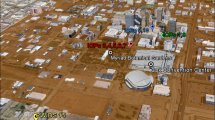Abstract
A comprehensive dataset on dispersion behind rectangular buildings has been used to analyse the performance of two dispersion models in respect to their handling of building effects: the Danish OML model and the US AERMOD model with the PRIME building algorithm; additionally, the German MISKAM model has been assessed. OML and AERMOD are regulatory plume models with limited requirements in terms of input and computing resources, whereas MISKAM is a computational fluid dynamical model, and as such much more demanding. For most scenarios considered, the degree of misprediction in respect to the maximum concentrations is less than a factor of two for OML and AERMOD. However, in respect to the concentration at a specific location, especially in the near field, both models often result in larger mispredictions. MISKAM provides more accurate predictions.
Similar content being viewed by others
References
CERC (2005) ADMS 3 Technical Specification (July 2005). Cambridge, UK. http://www.cerc.co.uk
Cimorelli AJ, Perry SG, Venkatram A, Weil JC, Paine RJ, Wilson RB, Lee RF, Peters WD, Brode RW (2005) AERMOD: a dispersion model for industrial source applications. Part I: general model formulation and boundary layer characterization. J Appl Meteorol 44: 682–693. doi:10.1175/JAM2227.1
Eichhorn J (1996) Validation of a microscale pollution dispersal model. In: Gryning SE, Schiermeier F (eds) Air pollution modeling and its application XI. Plenum Press, London, pp 539–548
Murakami S (1998) Overview of turbulence models applied in CWE-1997. J Wind Eng Ind Aerod 74−76: 1–24. doi:10.1016/S0167-6105(98)00004-X
Olesen HR, Løfstrøm P, Berkowicz R, Jensen AB (1992) An improved dispersion model for regulatory use—the OML model. In: Dop Hv, Kallos G (eds) Air pollution modeling and its application IX. Plenum Press, New York, pp 29–38
Olesen HR, Berkowicz R, Løfstrøm P (2007) OML: review of model formulation. National Environmental Research Institute, Denmark. NERI Techn Report 609, p 130. http://www.dmu.dk/Pub/FR609
Schulman LL, Scire JS (1980) Development of an air quality dispersion model for aluminium reduction plants. Environmental Research and Technology, Inc. Document P-7304 A
Schulman LL, Strimaitis DG, Scire JS (2000) Development and evaluation of the PRIME Plume Rise and building downwash model. JAPCA J Air Waste Manag Assoc 50: 378–390
Thompson RS (1991) Data report. Project Building Amplification Factors. Fluid Modeling Facility, US EPA, Research Triangle Park, NC 27711, 161 pp
Thompson RS (1993) Building amplification factors for sources near buildings—a wind-tunnel study. Atmos Environ A Gen 27: 2313–2325
URL 1: http://atmosphericdispersion.wikia.com/wiki/Thompson_Wind_Tunnel_data. Thompson wind- tunnel data
URL 2: http://www.dmu.dk/International/Air/Models/Background/Thompson_Intro.htm. Thompson wind-tunnel data used for validation of OML and AERMOD/PRIME
Author information
Authors and Affiliations
Corresponding author
Rights and permissions
About this article
Cite this article
Olesen, H.R., Berkowicz, R., Ketzel, M. et al. Validation of OML, AERMOD/PRIME and MISKAM Using the Thompson Wind-Tunnel Dataset for Simple Stack-Building Configurations. Boundary-Layer Meteorol 131, 73–83 (2009). https://doi.org/10.1007/s10546-009-9355-9
Received:
Accepted:
Published:
Issue Date:
DOI: https://doi.org/10.1007/s10546-009-9355-9




